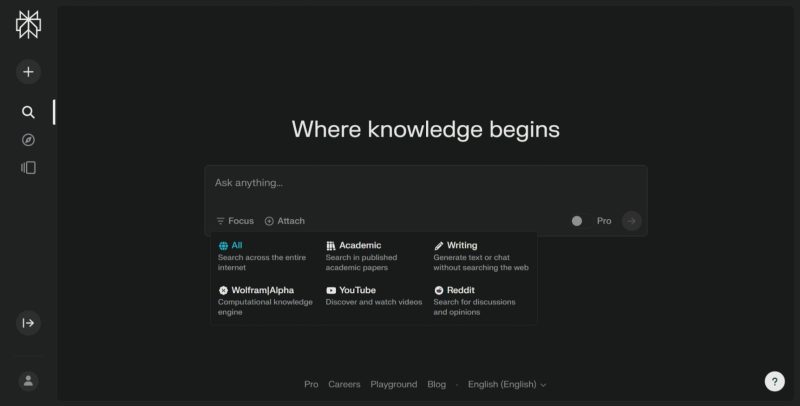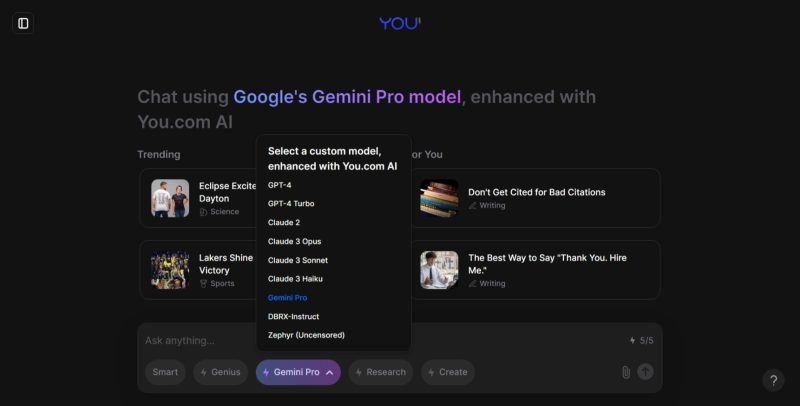The future of information search is already knocking on our doors as artificial intelligence-based search engines gain popularity. Though still in the early stages of development, their relentless progress is challenging Google’s two-decade dominance and traditional methods of exploring the Web. In this fascinating area where human curiosity meets the power of AI, let’s take a closer look at the three leading players in the market: Perplexity, Microsoft’s Bing Copilot, and You.com. Read on.
Comparing AI search engines – table of contents
How do AI search engines work?
AI search engines, such as Perplexity, Bing Copilot and You.com, use advanced language models and deep machine learning to understand user intent and provide relevant answers. Instead of presenting simple links, they interpret natural language queries using Natural Language Processing (NLP) and semantic search techniques.
A key element of these search engines is the language model – a powerful AI system trained on massive amounts of mostly textual data. The models learn linguistic and contextual patterns to generate consistent and meaningful answers.
When a user enters a query, the AI search engine – unlike Google Search, for example – processes the query using NLP algorithms that analyze syntax, meaning, and intent. The language model then generates potential answers and selects the best one.
For example, by asking the question “How do I tie a tie?”, Perplexity can generate step-by-step instructions, along with illustrations and links to instructional videos.
AI search engines are very different from the traditional search algorithms used by Google. Instead of presenting a list of links based on keywords, AI seeks to understand the user’s intent and provide a synthetic, comprehensive answer. This is a huge step forward in the way information is found online. But which search engines are worth using?

Source: You.com
Perplexity – a pioneering conversational AI search engine
One of the AI search engines challenging Google is Perplexity (https://www.perplexity.ai/). Its creators set out to revolutionize the way people find information online. As an alternative to traditional search engines, it allows you to ask questions directly and get concise, accurate answers backed by verified sources.
Perplexity’s unique selling point is its conversational interface and contextual understanding of the query. This search engine learns the user’s preferences and interests and adapts its answers as the dialog progresses.
The use of an advanced response algorithm, text prediction capabilities, and summarized results make it possible to provide useful information in a concise form.
In addition, Perplexity allows you to upload text files, source code, and PDFs so that the AI model can use their content to formulate answers. It’s a useful tool for tasks such as
- abstracting documents,
- explaining code snippets,
- translating documents into another language.
Perplexity’s conversational interface is based on a sophisticated natural language processing architecture. The search engine uses deep neural networks to analyze the context and intent of a query, and then generates a response using a language model trained on large data sets.
One of Perplexity’s distinctive features is the ability to narrow down the search area – this could include, for example, only academic sources, YouTube or conversations on Reddit.
For paying users ($20 per month), there is a Perplexity Pro subscription, which allows flagship models like Claude 3 and GPT-4 to be used for analyzing longer content and unlimited file transfers. The paid subscription also allows for unlimited use of Copilot, which suggests additional searches that will help us answer the original question.

Source: Perplexity.ai
Microsoft Copilot – the power of integration with Bing
Bing Copilot (https://www.bing.com/ ) is Microsoft’s proposal that combines the power of the GPT-4 language model with the traditional Bing search index. It aims to provide accurate answers to complex questions using deep machine learning techniques.
As with Perplexity, Bing Copilot offers an easy-to-use chatbot interface for asking questions and receiving answers from AI in natural language. Users of the Edge search engine can also use a very convenient side panel that allows, among other things, to ask questions to an open web page.
Bing Copilot can be particularly useful for exploratory queries that require in-depth analysis and synthesis of information from multiple sources. For example, the question “Why were chainsaws invented?” can be enriched not only with a concise answer, but also with links to additional sources and multimedia.
What’s more, Bing Copilot has the potential to personalize search results based on a user’s history and preferences. And the quality of search is constantly improving – Microsoft is working with technology companies like OpenAI to continually improve the capabilities of its AI search engine.
Entrepreneurs can use Bing Copilot, for example, to conduct market research and competitive analysis. Advanced search and natural language processing capabilities allow them to gain valuable insights from a variety of data sources.

Source: DALL·E 3, prompt: Marta M. Kania (https://www.linkedin.com/in/martamatyldakania/)
You.com – a wide range of models
You.com (https://you.com/) is another player in the AI search market, relying on advanced natural language processing and semantic understanding to deliver personalized search experiences. You.com offers a really wide range of models – it’s not just the popular GPT-4, Google Gemini or Claude, but also DBXR or Zephyr. Although it uses language models to interpret queries like Perplexity and Bing Copilot, You.com stands out for its comprehensive suite of search features.
You.com also has very useful modes:
- Smart – a free, basic semantic search,
- Genius – available for free 5 times a day, to search more you must purchase a subscription at $15 for an annual subscription or $20 for monthly access,
- Research mode – for in-depth search, analysis and comparison of sources,
- Create – with the ability to create images.
When comparing You.com’s search capabilities to traditional search engines, there is a significant advantage in understanding user intent and providing personalized answers. However, it is important to note that for simple queries, such as finding known facts or websites, traditional search engines may still be a better choice.

Źródło: You.com
Will AI search engines replace Google?
Although AI search engines such as Perplexity, Bing Copilot and You.com are becoming increasingly popular, replacing Google as the dominant player in the search engine market will not be an easy task. According to the latest data, Google still controls more than 90% of the global search engine market (https://www.statista.com/statistics/1358006/worldwide-mobile-market-share-of-search-engines/). AI search engines, on the other hand, have yet to match the giant in terms of search efficiency and speed.
The differences between AI search engines and Google’s traditional search model are also significant. Google has long been more than just a website with links; it is a true mini operating system, offering a range of tools and features integrated with search.
While AI search engines are getting better at interpreting queries and generating answers, Google is still the undisputed champion at providing quick links to websites, which is still a core function of a search engine.
In addition, Google collects vast amounts of data about its users to better tailor results to their preferences and context.
However, AI is most likely to outperform Google when it comes to queries that involve synthesizing information from multiple sources or finding hidden data. For queries such as “How do I take a screenshot on my Mac?”, AI search engines are able to extract key information and present it directly, whereas Google often serves up a thicket of ads and not very useful results.
AI search engines are constantly learning. The more data they receive, the better their language models and their ability to understand context. Over time, this may give them an advantage over Google’s static search algorithms. It may also be that Google will eventually make SGE, Search Generative Experience, more widely available, combining the power of AI with the Google search experience.

If you like our content, join our busy bees community on Facebook, Twitter, LinkedIn, Instagram, YouTube, Pinterest, TikTok.
Author: Robert Whitney
JavaScript expert and instructor who coaches IT departments. His main goal is to up-level team productivity by teaching others how to effectively cooperate while coding.
AI in business:
- Threats and opportunities of AI in business (part 1)
- Threats and opportunities of AI in business (part 2)
- AI applications in business - overview
- AI-assisted text chatbots
- Business NLP today and tomorrow
- The role of AI in business decision-making
- Scheduling social media posts. How can AI help?
- Automated social media posts
- New services and products operating with AI
- What are the weaknesses of my business idea? A brainstorming session with ChatGPT
- Using ChatGPT in business
- Synthetic actors. Top 3 AI video generators
- 3 useful AI graphic design tools. Generative AI in business
- 3 awesome AI writers you must try out today
- Exploring the power of AI in music creation
- Navigating new business opportunities with ChatGPT-4
- AI tools for the manager
- 6 awesome ChatGTP plugins that will make your life easier
- 3 grafików AI. Generatywna sztuczna inteligencja dla biznesu
- What is the future of AI according to McKinsey Global Institute?
- Artificial intelligence in business - Introduction
- What is NLP, or natural language processing in business
- Automatic document processing
- Google Translate vs DeepL. 5 applications of machine translation for business
- The operation and business applications of voicebots
- Virtual assistant technology, or how to talk to AI?
- What is Business Intelligence?
- Will artificial intelligence replace business analysts?
- How can artificial intelligence help with BPM?
- AI and social media – what do they say about us?
- Artificial intelligence in content management
- Creative AI of today and tomorrow
- Multimodal AI and its applications in business
- New interactions. How is AI changing the way we operate devices?
- RPA and APIs in a digital company
- The future job market and upcoming professions
- AI in EdTech. 3 examples of companies that used the potential of artificial intelligence
- Artificial intelligence and the environment. 3 AI solutions to help you build a sustainable business
- AI content detectors. Are they worth it?
- ChatGPT vs Bard vs Bing. Which AI chatbot is leading the race?
- Is chatbot AI a competitor to Google search?
- Effective ChatGPT Prompts for HR and Recruitment
- Prompt engineering. What does a prompt engineer do?
- AI Mockup generator. Top 4 tools
- AI and what else? Top technology trends for business in 2024
- AI and business ethics. Why you should invest in ethical solutions
- Meta AI. What should you know about Facebook and Instagram's AI-supported features?
- AI regulation. What do you need to know as an entrepreneur?
- 5 new uses of AI in business
- AI products and projects - how are they different from others?
- AI-assisted process automation. Where to start?
- How do you match an AI solution to a business problem?
- AI as an expert on your team
- AI team vs. division of roles
- How to choose a career field in AI?
- Is it always worth it to add artificial intelligence to the product development process?
- AI in HR: How recruitment automation affects HR and team development
- 6 most interesting AI tools in 2023
- 6 biggest business mishaps caused by AI
- What is the company's AI maturity analysis?
- AI for B2B personalization
- ChatGPT use cases. 18 examples of how to improve your business with ChatGPT in 2024
- Microlearning. A quick way to get new skills
- The most interesting AI implementations in companies in 2024
- What do artificial intelligence specialists do?
- What challenges does the AI project bring?
- Top 8 AI tools for business in 2024
- AI in CRM. What does AI change in CRM tools?
- The UE AI Act. How does Europe regulate the use of artificial intelligence
- Sora. How will realistic videos from OpenAI change business?
- Top 7 AI website builders
- No-code tools and AI innovations
- How much does using AI increase the productivity of your team?
- How to use ChatGTP for market research?
- How to broaden the reach of your AI marketing campaign?
- "We are all developers". How can citizen developers help your company?
- AI in transportation and logistics
- What business pain points can AI fix?
- Artificial intelligence in the media
- AI in banking and finance. Stripe, Monzo, and Grab
- AI in the travel industry
- How AI is fostering the birth of new technologies
- The revolution of AI in social media
- AI in e-commerce. Overview of global leaders
- Top 4 AI image creation tools
- Top 5 AI tools for data analysis
- AI strategy in your company - how to build it?
- Best AI courses – 6 awesome recommendations
- Optimizing social media listening with AI tools
- IoT + AI, or how to reduce energy costs in a company
- AI in logistics. 5 best tools
- GPT Store – an overview of the most interesting GPTs for business
- LLM, GPT, RAG... What do AI acronyms mean?
- AI robots – the future or present of business?
- What is the cost of implementing AI in a company?
- How can AI help in a freelancer’s career?
- Automating work and increasing productivity. A guide to AI for freelancers
- AI for startups – best tools
- Building a website with AI
- OpenAI, Midjourney, Anthropic, Hugging Face. Who is who in the world of AI?
- Eleven Labs and what else? The most promising AI startups
- Synthetic data and its importance for the development of your business
- Top AI search engines. Where to look for AI tools?
- Video AI. The latest AI video generators
- AI for managers. How AI can make your job easier
- What’s new in Google Gemini? Everything you need to know
- AI in Poland. Companies, meetings, and conferences
- AI calendar. How to optimize your time in a company?
- AI and the future of work. How to prepare your business for change?
- AI voice cloning for business. How to create personalized voice messages with AI?
- Fact-checking and AI hallucinations
- AI in recruitment – developing recruitment materials step-by-step
- Midjourney v6. Innovations in AI image generation
- AI in SMEs. How can SMEs compete with giants using AI?
- How is AI changing influencer marketing?
- Is AI really a threat to developers? Devin and Microsoft AutoDev
- AI chatbots for e-commerce. Case studies
- Best AI chatbots for ecommerce. Platforms
- How to stay on top of what's going on in the AI world?
- Taming AI. How to take the first steps to apply AI in your business?
- Perplexity, Bing Copilot, or You.com? Comparing AI search engines
- ReALM. A groundbreaking language model from Apple?
- AI experts in Poland
- Google Genie — a generative AI model that creates fully interactive worlds from images
- Automation or augmentation? Two approaches to AI in a company
- LLMOps, or how to effectively manage language models in an organization
- AI video generation. New horizons in video content production for businesses
- Best AI transcription tools. How to transform long recordings into concise summaries?
- Sentiment analysis with AI. How does it help drive change in business?
- The role of AI in content moderation


















